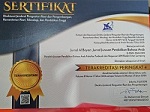Expressive Speech Act in Comments on Instagram BBC Arabic
Abstract
Keywords
Full Text:
PDFReferences
Abuata, Belal, and Asma Al-Omari. “A Rule-Based Algorithm for the Detection of Arud Meter in Classical Arabic Poetry.” The International Arab Journal of Information Technology 15, no. 4 (2018): 661-667.
Albantani, Azkia Muharom. “Social Media as Alternative Media for Arabic Teaching in Digital Era.” Alsinatuna: Journal of Arabic Linguistics and Education 4, no. 2 (2019): 148–161. https://doi.org/10.28918/alsinatuna.v4i2.2043.
Alharbi, Bedoor Y et al. “Automatic Cyber Bullying Detection in Arabic Social Media.” International Journal of Engineering Research and Technology 12, no. 12 (2019): 2330–2335.
Alsahafi, Morad. “Diglossia: An Overview of the Arabic Situation.” International Journal of English Language and Linguistics Research 4, no. 4 (2016): 1–11.
Anis, Muhammad Yunus. “Bentuk dan Latar Belakang Munculnya Hate Speech dalam Bahasa Arab: Analisis Morfologi dan Pragmatik.” Aksara 32, no. 1 (2020): 119–134. https://doi.org/10.29255/aksara.v32i1.447.119-134.
Anis, Muhammad Yunus, Likha Sari Anggreni, and Eva Farhah. “Hate Speech in Arabic Language: Case Study in Instagram Comments.” Journal of Islamic, Social, Econimocs and Development 3, no. 10 (2018): 28-36.
Arifianto, Muhammad Lukman et al. “Representative Speech Act in Arabic News Discourse: Study on Aljazeera and Al-Ahram.” Izdihar : Journal of Arabic Language Teaching, Linguistics, and Literature 5, no. 1 (2022): 17–34. https://doi.org/10.22219/jiz.v5i1.18161.
Asidiky, Zakie, and R Vindy Melliany Puspa. “The Commenters’ Reading Positions in an Online News Article’s Comment Column: A Speech Act Analysis on Media Discourse.” Bahasa dan Seni: Jurnal Bahasa, Sastra, Seni dan Pengajarannya 48, no. 1 (2020): 31-43. https://doi.org/10.17977/um015v48i12020p031.
Elimam, Ahmed Saleh, and Mohammad Khalid Husain. “A Literary Critical Discourse on Quranic History in Seventh-Century Arabia.” Journal of Al-Tamaddun 13, no. 2 (2018): 15–25. https://doi.org/10.22452/JAT.vol13no2.2.
Eskander, Ramy, Mohamed Elbadrashiny, Nizar Habash, and Owen Rambow. “Foreign Words and the Automatic Processing of Arabic Social Media Text Written in Roman Script.” Peoceedings of The First Workshop on Computational Approaches to Code Switching (2014): 1–12. https://doi.org/10.3115/v1/W14-3901.
Fitriyah, Tika, and Qoyyumul Fajar. “Al-Af’al al-Kalamiyyah al-Ta’biriyyah ‘an al-Madh Wa Adz-Dzamm Fi Instagram Al-Jazeera.” In Redefining Islamic Civilization: Perspective Across Disiplines and Societies. Yogyakarta: Faculty of Adab and Cultural Sciences, 2021.
Jawat Nur, Abdul. “Al-Afʻāl Al-Injāziyyah At-Taujīhiyyah dalam Novel Syaiʻun Fī Shadrī Karya Ichsān Abdu Al-Quddūs: Kajian Pragmatik.” Jurnal CMES 10, no. 2 (2018): 143-156. https://doi.org/10.20961/cmes.10.2.20202.
Karoui, Jihen, Farah Banamara Zitoune, and Véronique Moriceau. “SOUKHRIA: Towards an Irony Detection System for Arabic in Social Media.” Procedia Computer Science 117 (2017): 161–168. https://doi.org/10.1016/j.procs.2017.10.105.
Latifi, Yulia Nasrul, and Wening Udasmoro. “The Big Other Gender, Patriarki, dan Wacana Agama dalam Karya Sastra Nawāl Al-Sa’dāwī.” Musawa Jurnal Studi Gender dan Islam 19, no. 1 (2020): 1–20. https://doi.org/10.14421/musawa.2020.191.1-20.
Leech, Geoffrey N. Principles of Pragmatics. New York: Longman Group Limited, 1983.
Mahsun, Mahsun. Metode Penelitian Bahasa: Tahapan, Strategi, Metode, dan Tekniknya. Depok: Raja Grafindo Persada, 2017.
Marzali, Amri. “Agama dan Kebudayaan.” Umbara: Indonesian Journal of Anthropology 1, no. 1 (2016): 57-75. https://doi.org/10.24198/umbara.v1i1.9604.
Mubarak, Hamdy, Kareem Darwish, and Walid Magdy. “Abusive Language Detection on Arabic Social Media.” In Proceedings of the First Workshop on Abusive Language Online (2017): 52–56. https://doi.org/10.18653/v1/W17-3008.
Nashoih, Afif Kholisun, and Tika Fitriyah. “Zhawahir Al-Azdawajiyyah al-Lughawiyyah Fi Ittishalat Jamaáh al-Árb Fi Indunisiyya (Dirasah al-Halah Bi Malang Jawa al-Syarqiyyah) | Nashoih | Arabiyatuna : Jurnal Bahasa Arab.” Arabiyatuna: Jurnal Bahasa Arab 5, no. 2 (2021): 333-358. https://doi.org/10.29240/jba.v5i2.2585.
Nasrullah, Rulli. Media Sosial: Perspektif Komunikasi, Budaya, dan Sosioteknologi.. Bandung: Simbiosa Rekatama Media, 2017.
Pebrianto, Marhan, Hanna Daniarsa, and Diyanisa Awaliyah. “Types of Speech Acts Used on Instagram Comments of EllenDegeneres’ Account.” Seminar Nasional Struktural (2018): 208–215. https://doi.org/10.33810/274175.
Prabowo, Thoriq Tri. Memperebutkan Ruang Publik Virtual: Literasi, Hoax, dan Perdamaian. Yogyakarta: Zahir Publishing, 2020.
Sadat, Fatiha, Farnazeh Kazemi, and Atefeh Farzindar. “Automatic Identification of Arabic Dialects in Social Media.” In Proceedings of the First International Workshop on Social Media Retrieval and Analysis (2014): 35–40. https://doi.org/10.1145/2632188.2632207.
Sugiyono, Sugiono. Metode Penelitian Kuantitatif, Kualitatif dan R&D. Bandung: Alfabeta, 2008.
Sukma, Bayu Permana, Devi Ambarwati Puspitasari, Siti Afni Afiyani, Indah Okitasari, Dian Palupi, Fani Kusumawardani, Husnul Khatimah, and Reza Amarta Prayoga. “Pola Tuturan Perundungan Siber (Cyberbullying) di Kalangan Pelajar Indonesia.” Bahasa dan Seni: Jurnal Bahasa, Sastra, Seni, dan Pengajarannya 49, no. 2 (2021): 205–223.
Syah, Nur Aini. “Kesantunan Tindak Tutur Direktif dalam Talk Show Satu Jam Lebih Dekat di Tv One (Tinjauan Pragmatik).” Adabiyyāt: Jurnal Bahasa dan Sastra 1, No. 1 (2017): 94-111. https://Doi.Org/10.14421/Ajbs.2017.01105.
Tarigan, Henry Guntur. Pengajaran Pragmatik. Bandung: Percetakan Angkasa, 2009.
Tohe, Achmad. “Bahasa Arab Fusha dan Amiyah Serta Problematikanya.” Jurnal Bahasa dan Seni 33, no. 2 (2005): 200-214.
Umar, Ahmad Mukhtar, Mu’jam al-Lugah al-‘Arabiyah al-Mu'ashirah. Banten: Alam al-Kutub, 2008.
Wafy, Ali Abdul Wahid. Fiqh al-Lughah. Mesir: Nahdhah Mesir , 2004.
Wijana, Dewa Putu. Dasar-Dasar Pragmatik. Yogyakarta: Andi, 1996.
Yoyo, Yoyo. “Ujaran Kebencian (Khitāb al-Karāhiyah) dalam Ruang Kontestasi Sosial Politik Arab Kontemporer.” Adabiyyāt: Jurnal Bahasa dan Sastra 3, no. 1 (2019): 120–139.
Yule, George. Pragmatik. Yogyakarta: Pustaka Pelajar, 2006.
DOI: http://dx.doi.org/10.24042/albayan.v14i2.12127
Refbacks
- There are currently no refbacks.
Copyright (c) 2022 Jurnal Al Bayan: Jurnal Jurusan Pendidikan Bahasa Arab
License URL: https://creativecommons.org/licenses/by-nc-sa/4.0
Editorial Office:
Jurnal Al Bayan: Jurnal Jurusan Pendidikan Bahasa Arab, Arabic Education Study Program, Faculty of Education and Teachers Training, Unversitas Islam Negeri Raden Intan Lampung
Jl. Endro Suratmin 1 Sukarame, Bandar Lampung 35131-Indonesia
e-mail: jurnalalbayan@radenintan.ac.id
http://ejournal.radenintan.ac.id/index.php/albayan/index
Jurnal Al Bayan: Jurnal Jurusan Pendidikan Bahasa Arab is licensed under a Creative Commons Attribution-ShareAlike 4.0 International License. p-ISSN 2086-9282 | e-ISSN 2549-1229









